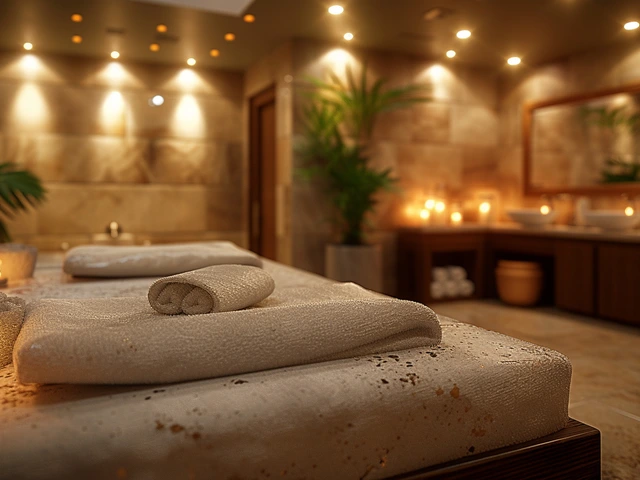Hellerwork: Rethinking Body Alignment for Better Health

Ever felt like your body's a bit out of whack? You're not alone, and that's where Hellerwork steps in. This not-so-buzzy but revolutionary approach goes beyond typical massage or therapy techniques. It's more like a three-in-one package that aims to get your body aligned while nurturing your emotional well-being.
Now, Hellerwork is built on a trio of elements: deep tissue work, movement education, and heightened body awareness. It's like having a seasoned team helping your body remember what it's like to feel good. Accept it; our bodies don't always get the benefit of doubt when it comes to stress or injuries. So why not give them a little helping hand (or hands, in this case)?
- What is Hellerwork?
- The Three Components
- Benefits of Hellerwork
- Hellerwork vs. Other Therapies
- Tips for Getting Started
- Finding a Practitioner
What is Hellerwork?
So, what exactly is Hellerwork? It's a type of structural integration therapy created by Joseph Heller back in the 1970s. Unlike traditional massages, it's more comprehensive and tackles not just your muscles but also how you move through life—literally!
Imagine you’re an onion, with layers to peel away that's exactly what Hellerwork does. It’s designed to release patterns of tension by addressing every layer, starting from the deep tissue to your mental habits. The goal? Total alignment that makes you feel lighter, more balanced, and maybe even taller.
How it Differs from Other Therapies
Unlike your regular massage that focuses on relaxation, Hellerwork digs deep into the nitty-gritty of what’s happening with your body. Practitioners use their hands to apply pressure on fascia, which is that connective tissue enveloping your muscles. The idea is to relieve chronic tension and get your body back to its natural form.
And here’s the kicker—it’s not just physical. Hellerwork also involves movement education and emotional reflection. So, while you're getting that fascia loosened up, you're also learning how to keep it from getting all bunched up again in the future.
Components of Hellerwork
The process typically involves 11 sessions, each focusing on a different part of the body. Sessions might vary, but there's usually a mixture of deep-tissue hands-on techniques, vocal guidance, and even advice on how to change your posture or daily habits.
- Deep Tissue Bodywork: Addressing the tension in specific areas.
- Movement Education: Re-learning how you move to optimize alignment.
- Emotional Reflection: Conversations that uncover emotional factors contributing to physical issues.
So, if you've tried just about every other treatment and still find yourself sidelined by body pain or misalignment, Hellerwork might be the mix of art and science your body’s been craving.
The Three Components
To truly grasp what Hellerwork is all about, you've got to break it down into its key components. Think of it as a three-legged stool. Knock one out, and the whole thing topples. Luckily, these components don't need a degree to understand—they're all about making things simple and effective.
Deep Tissue Bodywork
At the heart of Hellerwork is deep tissue bodywork. This isn't your regular spa day massage. The focus here is on realigning the body's connective tissue, which can get all tangled up due to bad posture or old injuries. The aim is to release tension and improve the body's natural alignment. You won't just feel better; you'll move better, too.
Movement Education
Now, onto movement education. Sure, it might sound fancy, but it's pretty straightforward. It's about learning how to use your body the way it was meant to be used. The idea is to build better habits and posture through everyday actions. If you've ever caught yourself slouching or lifting things the wrong way, movement education in Hellerwork will set that straight.
Mindfulness and Awareness
Last, but not least, is this element that's as crucial as the others: mindfulness. Being aware of how you move and what your body is telling you goes a long way. This isn't just about improving physical alignment but enhances emotional well-being. Thoughts and stress can mess with your body's structure, so learning to be aware can help unravel that.
These three components form the backbone of Hellerwork. They're interconnected, supporting one another to create a therapy method that's as comprehensive as it is unique.
Benefits of Hellerwork
Thinking of trying something new for those nagging aches and pains? Why not give Hellerwork a shot? This holistic therapy is geared towards improving your body's alignment and overall well-being. But what exactly does it offer? Let's break down some key benefits.
Improved Posture
Who doesn't want to stand tall and look confident? Hellerwork helps improve posture by realigning the body's structural imbalances. Over time, everyday habits can lead to slouching or uneven postures. By focusing on body alignment, Hellerwork can help correct these issues, allowing you to carry yourself with grace and confidence.
Relief from Chronic Pain
Living with chronic pain is, well, a pain! Hellerwork targets the root of such discomfort through deep tissue bodywork. By addressing underlying issues, it provides a more lasting relief than usual quick-fixes. Whether it's back pain or stiff shoulders, many find this therapy offers a more sustained comfort level.
Enhanced Flexibility
Who knew a bit of alignment adjustment could make touching your toes easier? With Hellerwork, many folks report improved flexibility. By working on muscle and fascia layers, this technique can free up your range of motion and make those yoga sessions a breeze.
Emotional Release
Physical tension often has an emotional counterpart. Hellerwork acknowledges this connection, allowing you to release not just physical knots, but emotional ones too. Who wouldn't want to feel a little lighter, both physically and mentally?
Improved Movement
The movement education component of Hellerwork teaches you how to move more efficiently. It’s like recalibrating your body's natural mechanics, making your movements smoother, more coordinated, and less prone to injury.
| Number of Sessions | Common Results |
|---|---|
| 1-3 | Initial Pain Relief |
| 4-8 | Improved Posture and Flexibility |
| 9-11 | Enduring Benefits and Emotional Balance |
Consider giving Hellerwork a try to experience these life-changing benefits. Whether you're looking to ease pain, stand a little straighter, or just feel better in your skin, it could well be worth it.

Hellerwork vs. Other Therapies
It's normal to wonder how Hellerwork measures up to other bodywork therapies. On the surface, it might seem similar to approaches like massage therapy or chiropractic care, but there's more than meets the eye.
Massage Therapy vs. Hellerwork
Massage therapy is all about relaxing muscles and relieving tension. You get in, have a session, and feel relaxed afterward. Simple, right? But Hellerwork has a deeper agenda. It's not just treating muscles; it's about reorganizing the whole body's structure, addressing the root cause of discomfort rather than just the symptoms.
Chiropractic Care vs. Hellerwork
Chiropractors focus primarily on the spine, aiming to correct misalignments. While it’s great for many, Hellerwork takes a broader approach. Yes, the spine is crucial, but so are the muscles, fascia, and how they work together. It’s more about embracing the body as a whole interconnected unit.
Rolfing vs. Hellerwork
Rolfing is probably the closest comparison. Both share a focus on structural integration and deep tissue work, but Hellerwork adds a unique twist with its emphasis on movement education and dialogue. It’s about retraining the body to move efficiently and recognizing emotional patterns that cause strain.
The Emotional Component
This is the real kicker—while other therapies focus mainly on physical aspects, Hellerwork dives into the emotional realm too. The belief is that sometimes, our pains are tangled with emotional experiences. By recognizing and addressing them, you get a dual benefit: physical alignment and emotional release.
With Hellerwork, you're looking at a holistic package. It treats you as a whole person rather than just focusing on isolated parts. So, whether you're dealing with chronic pain or just want better posture and well-being, it’s an option worth considering.
Tips for Getting Started
If you're curious about diving into Hellerwork but aren't sure where to start, you're in the right spot. Getting started with this holistic therapy isn't as daunting as it might seem, and a few tips can help set you on the path to improved body alignment.
Understand What You're Signing Up For
Before jumping in, read up on what Hellerwork entails. It's not your typical massage session. Instead, it combines bodywork, movement education, and awareness practices. You'll be working closely with your practitioner to focus on both the structural and emotional aspects that might be causing discomfort.
Choose the Right Practitioner
Finding a good practitioner is crucial. Look for certified Hellerwork Structural Integrators. Check reviews, get recommendations, or even reach out to local wellness centers to get pointed in the right direction.
Set Realistic Goals
Whether you want to address chronic pain, improve posture, or just feel better overall, it's important to have clear objectives. Chat with your practitioner about what you hope to achieve, and remember, change doesn’t happen overnight.
Come Prepared
Wear comfortable clothing that allows you to move freely. Sessions generally last around 90 minutes, so plan your schedule accordingly. Silence your phone and give yourself this time to fully engage in the process.
Stay Committed
Hellerwork isn't a quick fix. It's usually a series of 11 sessions designed to work through your body's alignment step by step. Stick with the program to experience the best results.
- Educate yourself: Read books or watch videos about Hellerwork to get a broader understanding.
- Track your progress: Journal about your sessions and how you feel before and after. This can help both you and your practitioner tailor the sessions to fit your evolving needs.
- Embrace the changes: As you go through each session, you might notice various changes—some immediate, others more gradual. Welcome these shifts as part of the journey.
With these tips, you'll be better prepared to start your Hellerwork journey, setting yourself up for healthier body alignment and a more balanced life overall.
Finding a Practitioner
So, you're convinced that Hellerwork might just be the thing your body's been missing. But how do you find the right practitioner? You're in luck, because connecting with a trained professional is easier than you might think.
Check for Certification
First off, you want to make sure the practitioner is certified in Hellerwork. Look for someone who has gone through the official Hellerwork Structural Integration training program. This ensures they truly know their stuff. Certification often involves a pretty intensive course, focusing on theory, technique, and a lot of hands-on practice.
Research and Reviews
Nowadays, a quick online search can tell you a lot about potential practitioners in your area. Look at reviews from other clients. They’ll often provide insights into what you can expect. Are they professional? Do they have a good track record? And don't shy away from asking for recommendations.
Initial Consultation
Most Hellerwork professionals offer some sort of initial consultation or session. This is like a 'try before you buy' kind of deal. It gives you the chance to see if you're comfortable with their approach and if they’re someone you want to work with long-term.
Location and Convenience
Keep practicality in mind. Is their office easy to get to? Consistency is key in structural integration, so you'll want someone whose location won't become a burden down the line.
Cost and Payment Options
Consider what you're willing to spend. Prices might vary based on experience or location. Some practitioners might also offer packages or payment plans, which can be easier on the wallet.
With these pointers, you're all set to find the right match and start experiencing the potential life-changing benefits of Hellerwork.





